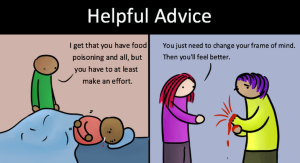
Source: Pixgood
The last several years have produced a cocktail of emotions for trans women — from epic fails to the emergence of some long-awaited sheroes and role models. The battle for us to be recognized in this society as existing and as human is on-going and hard-fought.
But behind all of the activism and social apprehension, it can be forgotten that many trans women also crave fulfilling romantic relationships. Maybe that idea is denied to us because our humanness is so often left to the side.
Some of our sheroes, such as Janet Mock, have criticized society for creating a stigma — through a volatile mixture of homophobia, misogyny, and transphobia, which creates an intersection known as “transmisogyny” — around being attracted to trans women.
Fortunately, there are those who have broken through the stigma, but may be weary about moving forward due to some of the pitfalls and complications that come with romancing a trans woman, such as concerns about being fetishistic or if certain interactions might make their potential/partner feel dysphoric.
Unfortunately, there is no roadmap for guidance on how to romance trans women.
Every trans woman is different, obviously, and the number one way to know that you’re treating your partner the way she wants to be treated is to—well—talk to her about it.
If you take nothing else away, let it be that the process of flapping your jaw around, making noise, and ending it with a question mark is one of the most useful tools at your disposal.
While women of different races and abilities all have unique experiences with both relationships and transmisogyny, we’ll try to talk in general about some of the ways in which you can both support your lover and avoid some hurtful mistakes by looking at situations that happen in public, in private, and in bed.
In Public and Online
1. Gendering and Pronouns
Living as a trans woman can often be tricky business.
We know that acceptance is thin, discrimination is thick, and, for many trans women, the only way to navigate between loving ourselves and surviving in our culture is to present ourselves as a woman when we can and a man when we must.
This is a complicated and degrading process, but it can be the thread of difference between making ends meet at a stable job and falling into unemployment or being disowned by our families.
Unfortunately for our partners, that requires them to sometimes have to play along with the charade and misgender us for the sake of our safety and well-being.
It’s important to ask your partner if there are any places where she doesn’t feel safe being out as trans (such as school or work), or if there are any people for whom she isn’t ready to tell about her being trans (which may mean being quiet on Facebook altogether).
Doing this may be uncomfortable for both of you, but your partner knows what’s best for her.
Alternatively, your partner may be out, loud, and proud to everyone — awesome!! Strangers who have yet to know better, however, may still misgender her — not so awesome.
On top of knowing when not to out her, it’s good to also ask when (and if) you should correct people if they call her the wrong pronoun.
It can be tricky to remember each situation and nuance, but your partner will appreciate the extra work to make sure she feels safe and respected.
2. Public Displays of Affection (PDA)
Hand-holding and coffee shop kisses are adorable and romantic, but aside from some people just not being comfortable with PDA, trans women may have an extra layer of anxiety around it for fear of attracting homoantagonists.
Lesbians and bisexual folx who are reading likely have an understanding of this anxiety already, but straight men often have some confusion around it.
It’s not that we don’t like you. It’s not that we’re ashamed of you. It’s just that we might not be feeling up to the risk of being called “f*ggots,” “d*kes,” or being profiled as someone who provides commericial sex.
Always be sure to have open communication with your partner about when she wants to or doesn’t want to participate in PDA and, especially important, be sure she knows that you aren’t offended or hurt if she decides not to.
Guilt trips are never in a recipe for success.
In Private
1. Understanding Dysphoria
Managing dysphoria (which is the distress or discomfort that occurs when the gender someone is assigned does not align with their actual gender) is a big struggle for many transgender people.
Dysphoria, in a simple definition, is the anxiety and depression that comes from feeling your body’s sex is in some way wrong or misaligned with your gender identity.
Not every trans woman experiences dysphoria, but those that do usually experience it in different degrees throughout the day, sometimes spiking because of various triggers. Similar to PTSD, these triggers differ from person to person.
Knowing what triggers your partner’s dysphoria will help you avoid triggering it yourself.
For instance, if she is particularly hostile toward her body hair, touching it or making comments about it — even if it seems like it would be appropriate for the situation — might not be the best decision.
Having an open, understanding, and compassionate dialogue with your partner about her dysphoria will not only show your support for her, but it will also give you insight into what parts of her body make her uncomfortable so you know what to avoid interacting with and how.
Every woman deals with her dysphoria differently and has different coping methods for it. Sometimes, it can be as simple has having someone acknowledge and pay attention to her femininity.
Talk to your partner and ask if there’s any way you can help lessen her dysphoria on days when it’s particularly difficult for her to manage.
2. Gender Roles
Along the same lines of dysphoria comes the discussion of gender roles.
In general, gender roles are a pretty nasty subject given societal pressures to conform to one of only two based exclusively on your body.
But for many trans women who have already renounced the gender constraints that society has enforced on their bodies, performing feminine-typical gender roles can be a very liberating experience.
Cissexism, however, is alive and well and exists not only within cisgender people, but is internalized in trans women as well.
For this reason, interactions between trans women and their partners can often slip into a pattern of masculinizing the trans woman.
A prime example of this is cuddling with cis women who may have internalized their own gender roles that they should be the one held, not the one doing the holding.
While this expression isn’t inherently problematic, this can lead to a trend where the trans woman is predominantly the one doing the holding and performing what feels like a masculine gender role — making her feel dysphoric at worst, delegitimized at best.
Even in Queer relationships where gender roles might seem obsolete, it’s good to take a step back and take note to see if those roles truly are diminished, or if they’re just not being talked about.
And, as always, be sure to talk to your partner about what sort of interactions might make them feel uncomfortable in their body and which ones make them feel respected and empowered.
3. Responding to Depression and Anxiety
Living in a toxic culture definitely takes its toll, and for transgender people that means a significantly increased risk of anxiety and depression.
Dysphoria often facilitates anxiety and panic. Knowing this can help you gauge your partner’s anxiety levels if she tells you that she’s feeling dysphoric. And though it’s not guaranteed, helping your partner ease her dysphoria may also lower her anxiety levels.
Second, depression and anxiety come with a litany of bad patterns, including unregulated eating and sleeping habits and denigrating self-talk.
One of the best ways to lessen the effects of these diseases is to help your partner recognize these habits and, if she wants you to, help break them.
Your partner will always know what would be best for her, though, so keeping in communication with her and paying attention to her desires is paramount.
Under the Sheets (NSFW Language)
1. Parts and What to Call Them
Contrary to popular belief, not every trans woman has undergone sexual reassignment surgery (SRS). In fact, for many trans women, it isn’t a top priority.
A major apprehension around having sex with trans women, though, is the uncertainty that comes with bodily names having a gendered overtone.
One need only research phallic symbolism and imagery to understand the cultural connection between the penis and masculinity. So wouldn’t calling a trans woman’s genitals a penis make her uncomfortable?
Not necessarily! Many trans women have reclaimed the notions around their penises and recognize them as a feminine part of them.
After all, it’s not like there’s an empty void of femininity that only exists over their crotch — their package is no less feminine than their left pinky finger.
But while some have been able to reclaim this idea, others still are extremely uncomfortable with their sexual configuration. These women may prefer that their junk be called a clit, instead, since they are both essentially the same organ.
Or they may prefer for it to be called something else entirely. The best way to know is – you guessed it – by talking to her.
Before sex, ask her what makes her feel good and what she likes and allow her to tell you on her own terms, asking for clarification if you need to. (This is also a good time to talk about STIs and protection methods!)
2. Fucking
There’s more than one way to have sex with a trans woman. In fact, there are enough ways that Mira Bellwether was able to write an 80 page zine about them, which she so eloquently titled Fucking Trans Women (FTW).
While I think everyone should read the zine from cover to cover, there are a few important highlights that are worth describing.
Muffing, for instance, was made popular by FTW and refers to inverting the testes and scrotum back into the cavity that they came out of during puberty.
This newly exposed cavity can then be used as a pleasure center that can be stimulated with a vibrator, fingers, or a penis, similarly to a vagina.
Another point that Bellwether brings up in FTW is that just because we’re interacting with a penis doesn’t mean we need to assume that it should be erect.
Stimulating a flaccid penis is rarely, if ever, a consideration in sexual discussion, but is a very real possibility.
Especially considering that your partner may be undergoing hormone replacement therapy, which can diminish sex drive and prevent erections, this allows for a whole new playground of pleasure and experimentation.
All, or none, of these ideas could be appealing to your partner and, as per usual, it’s best to talk to her, ask questions, and have conversations about how she likes to fuck and the best ways for the both of you to fuck together.
***
Despite the fact that there are very few cultural texts to help people in our culture understand how to interact with and love trans women, the key lies within respecting their struggle and personhood and, of course, communicating freely and openly about any and every topic.
The rest is determined by you and how you naturally show your affection.
While respecting your trans partner is filled with nuance and may even require you to unlearn some habits, it should begin to click together very quickly as soon as you consciously begin putting these into practice.
The tradeoff of creating a healthy relationship for you and your partner is definitely worth the work.
[do_widget id=”text-101″]
Kaylee Jakubowski is a Contributing Writer for Everyday Feminism. She is a trans, Queer feminist with specific interests in ecofeminism, anti-imperialism, Queerness, and statistical approaches to social justice work. Xe is pursuing a B.S. in Statistics with a minor in Women’s & Gender Studies. Feel free to Like her Facebook Page, follow her on Tumblr, or see what she’s up to musically. Read her other articles here.
Search our 3000+ articles!
Read our articles about:
Our online racial justice training
Used by hundreds of universities, non-profits, and businesses.
Click to learn more




















